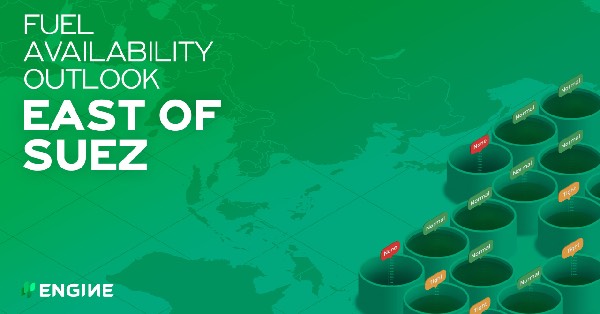Singapore and Malaysia
Prompt VLSFO availability remains constrained in Singapore, with certain suppliers struggling to fulfill delivery commitments. Lead times of eight days are currently recommended for VLSFO. HSFO supply is also under pressure, with lead times spanning between 4-10 days, almost unchanged from the previous week. On the contrary, LSMGO supply remains abundant, and shorter lead times of 2-4 days are generally recommended.
Enterprise Singapore’s latest data reveals that Singapore’s residual fuel oil stocks have averaged 3% lower this month compared to January. The Southeast Asian bunker hub has witnessed a 12% decrease in net fuel oil imports so far in February, despite increases in both imports and exports. Fuel oil imports have risen by a modest 144,000 bbls this month, while fuel oil exports have surged by a notable 774,000 bbls, contributing to inventory drawdowns.
Meanwhile, the port’s middle distillate stocks have seen a significant 21% increase this month, touching nearly 8.50 million barrels, the highest level since November.
In Malaysia’s Port Klang, VLSFO and LSMGO availability remains stable, with several suppliers able to supply both grades of smaller quantities. On the other side, HSFO supply is very tight, with most of the suppliers lacking supply.
China, East Asia and Oceania
In Zhoushan, bunker fuel availability has improved amid subdued demand, leading several suppliers to recommend shorter lead times. VLSFO and LSMGO now have lead times of 2-4 days, while HSFO stands at 4-6 days, much shorter than last week’s 5-7 days.
Moving to China, Dalian faces tight VLSFO and LSMGO supply, while Tianjin encounters tightness across all grades. Qingdao has limited prompt availability for VLSFO and LSMGO, with HSFO supply subject to enquiry. In southern ports like Shanghai and Guangzhou, VLSFO and LSMGO are tight, with HSFO also facing constraints in Shanghai. However, Fuzhou, Yangpu, and Xiamen boast good availability of both low-sulphur fuel grades.
Bunker fuel supply is mostly good in Hong Kong amid average demand. Lead times of around seven days are recommended, similar to the previous week. Some suppliers can offer prompt dates for smaller quantities, a source says.
South Korean ports experience tight availability across all fuel grades despite weak demand, with lead times ranging between 8-14 days. Some suppliers can still offer shorter lead times of around three days, but these deliveries depend on quantity. Adverse weather forecasts for key South Korean ports of Ulsan, Onsan, Busan, Daesan, Taean, and Yeosu may impact bunker deliveries intermittently throughout the week.
In Japan, sluggish bunker demand persists due to elevated prices and limited cargo availability, with adverse weather conditions further denting demand. Tokyo’s VLSFO was priced about $74/mt higher than Zhoushan’s on Tuesday and $65/mt higher than Singapore’s. Lead times vary across key Japanese ports, from 5-8 days in Tokyo, Chiba, Osaka, and Kobe, to longer periods of 11-15 days in the ports of Mizushima and Oita.
Subic Bay in the Philippines and the Vietnamese port of Ho Chi Minh anticipate difficult bunkering conditions throughout the week, while adverse weather is expected in the Thai ports of Koh Sichang and the Kiwi port of Tauranga on 3-4 March, potentially impacting bunker operations in these regions.
South Asia
Multiple Indian ports, including Kandla, Cochin, Chennai, Visakhapatnam and Haldia, are grappling with supply shortages for VLSFO and LSMGO. Mumbai and Paradip are the most affected, with some suppliers almost running out of VLSFO and LSMGO stocks, according to a source.
Adverse weather conditions are forecast for Wednesday at the Indian port of Sikka, which may disrupt bunkering operations at the port.
In contrast to most Indian ports, VLSFO and LSMGO supply is ample in the Sri Lankan port of Colombo.
Middle East
Several shipping firms continue to avoid Rea Sea transits as Houthis scales up attacks on commercial ships passing the area. Most of these ships have been using the longer route around Africa instead of the shorter Suez Canal route. This shift in shipping routes is gradually impacting bunker demand in Fujairah.
Despite a slight slowdown in demand, prompt availability remains constrained in Fujairah due to backlogs caused by weather-induced disruptions over the weekend. Suppliers advise lead times of 7-10 days, although some can still offer prompt deliveries.
Similar supply constraints are observed in the UAE port of Khor Fakkan, with most suppliers recommending lead times of 7-10 days. However, the situation differs in the Saudi Arabian port of Jeddah, where the availability of both VLSFO and LSMGO remains satisfactory. Conversely, some suppliers in Djibouti are experiencing low VLSFO stocks but still have LSMGO available.
Meanwhile, the Omani ports of Sohar, Salalah, Muscat, and Duqm boast an ample supply of LSMGO, with prompt dates readily available.
Source: ENGINE









































